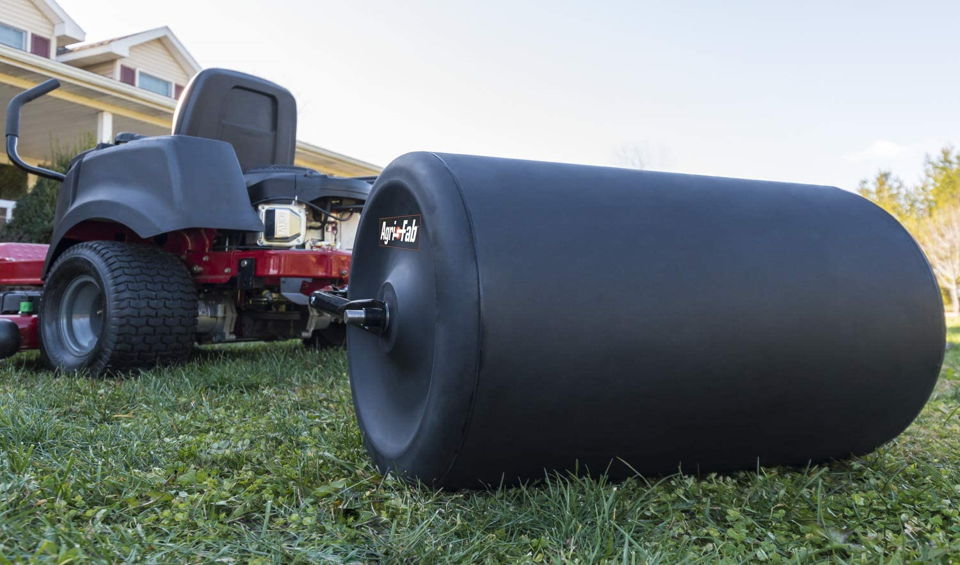As an Amazon affiliate, we earn a commision from qualifying purchases.
Pick your ideal lawn roller alternative from the devices we share in this article
We wrote about lawn roller uses the other day (find the article here) and we feel it’s important to tell you about alternative equipment that work as well as lawn rollers.
Here is the thing: there is a world of choice if you feel that a lawn roller is out of reach or perhaps it doesn’t bring the result you want in your yard.
Meet them below..
Our recommended lawn roller alternative
Some of the alternatives we cover below are incredibly affordable and good for those with budgetary constraints.
1. Use Plywood (alternative when laying sod)
One of the most inexpensive alternatives to lawn rollers is that sheet of plywood lying around your home.
Plus, it’s amazingly simple to use.
Follow these steps to help your sod bond with the soil….
Step 1:
Place a 4 ft. by 8 ft. piece of plywood on your new lawn.
Step 2:
Walk over it to press your sod solidly into the soil. We suggest that you invite a friend, if possible, to walk alongside you.
The plywood distributes the applied weight evenly and will have an impact similar to a commercial lawn roller.
2. Use a power rake to smooth bumpy lawn when seeding
Bumpy, rough, uneven yards are annoying and you need a heavy lawn roller to alleviate the problem, particularly when dealing with larger humps.
A good substitute would be a power rake as long as you follow the right procedure.
Follow this process to flatten all the unsightly depressions:
Step 1:
The first thing to do is core aerate the lawn to reduce existing soil compaction.
Step 2:
Now power-rake the site (you can rent or buy an electric power rake cum dethatcher such as this) .
This breaks up the soil cores brought to the surface by your core aerator and more importantly, the bumps.
Step 3:
The power rake may have deposited thatch to the surface and you should rake it off as well before sowing the appropriate grass seed.
Step 4:
With a leaf rake, work the seeds into the soil.
Be sure to keep the soil dump to stimulate germination.
Your lawn should certainly be thicker and the ground less rough after completing these steps.
3. Use a Bobcat to smooth a lawn that mirrors a minefield
Though a bit pricey to hire, a Bobcat is perhaps the best weapon to deploy on a large, groove-ridden yard (the type resembling a battlefield).
It’s pretty fast and your yard should be perfectly level in no time.
Tip: If you don’t have the budget to hire a bobcat, employ the combination of a shovel and pickaxe (or mattock) to shave the uneven lumps/holes made by pesky rodents and digging dogs.
4. Use a leveling drag instead of a grass seed roller
If you’re smoothing the lawn to cultivate it, a leveling drag may suffice.
Most are designed to attach to almost any UTV, ATV, or utility tractors for easy towing.
You want to make pass after pass over the surface until it’s leveled enough for reseeding.
5. Try a land plane
Another machine that wonderfully takes the lumps out is a land plane (for lawns that aren’t exceedingly rough).
We recommend that you stack some weights on top to create more down pressure on this thrilling lawn leveller.
That makes its (and your) life easier.
6. Use a drag broom
A drag broom would be another likely option.
If this is the approach you wish to take, we’d lean toward a drag broom that level out things even in mud (they’re available in the market).
Lawn roller alternative: Other options
- You can also consider rolling the lawn with asphalt roller– in most cases, anything from 2000 lbs. should knock down mole tunnels and fix minor tire ruts well.
- Roll the yard with a box blade (with scarifier teeth)- this fills the low spots and can knock off the highs reasonably well as it cuts through the turf and may be worth trying. Be ready to reseed the lawn.
- Use a tiller followed by a harrow- These two work great and levels out the surface giving it a cute finish.
When to roll lawn
As you might have heard, hardly do you need to roll a lawn.
In fact, rolling could do more harm than good to the yard especially if you go ahead with the chore when it’s not necessary.
Here is when you should roll a lawn (either with an ideal lawn roller alternative or a conventional lawn roller).
- When planting fresh grass– rolling after sowing will help compact the soil better so that the seeds will touch it properly. This helps the seeds germinate speedily.
- After laying sod- rolling the sod (start by watering the grass) presses the roots more firmly into the ground and can help the roots to establish quickly.
- Repairing the lawn– roll the backyard to bring back the smooth uniformity that was disturbed by moles or insects. It may also be effective in leveling ruts and bumps left behind by children if they’ve been playing in the lawn. Use it to get rid of frost heave damage too after every harsh winter.
Final comments
Unless absolutely unavoidable, only use a garden roller (or your preferred lawn roller alternative) on dry soils.
Rolling wet soils could lead to more compaction making it tough for your seeds to sprout or sod roots to get established.
That said, you should always make the soil moist before rolling a lawn for the best result.
One more thing: It’s best to use lighter rolling solutions as compared to heavier ones, again because of the risk of causing more soil compaction.
PS: For those who would rather stick to a conventional lawn roller instead of the listed alternatives, here is an inexpensive model to consider.

